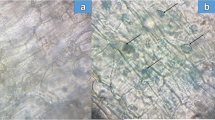Abstract
The effects of cropping pea or barley and the decomposition of their residues on Phymatotrichum root rot of cotton were studied for five years. Little or no changes occurred in pH, content of carbon or moisture in the soil, but there were significant increases in populations of competitive microflora. Best control was obtained in infested soil which was cropped to either pea or barley in winter or in soil which received the higher tonnage of Papago pea plants. Reduction in incidence of root rot may be attributed to premature germination of overwintering propagules making hyphae vulnerable to the chemicals of decomposition and to competition of microflora in the soil.
Similar content being viewed by others
References
Hervey, R.J. 1961. Effect of differing carbon-nitrogen residues on actinomycetes and microbial antagonists in Texas Blackland soils. Bacteriol. Proc. 61: 55.
King, C.J. 1937. A method for the control of cotton root rot in the irrigated southwest. USDA Circ. 425. 9 p.
King, C.J., D. Hope & E.D. Eaton. 1934. Some microbiological activities affected in manurial control of cotton root rot. J. Agr. Res. 49: 1093–1107.
King, C.J. & H.F. Loomis. 1926. Experiments on the control of cotton root rot in Arizona. J. Agr. Res. 32: 297–310.
King, C.J. & H.F. Loomis. 1929. Cotton Root Rot Investigations in Arizona. J. Agr. Res. 39: 199–221.
Pammel, L.H. 1888. Root Rot of Cotton, or ’Cotton Blight’. Texas Agr. Expt. Sta. Bull. 4: 50–65.
Pammel, L.H. 1889. Cotton Root Rot. Texas Agr. Exp. Sta. Bul. 7: 61–91.
Rogers, C.H. 1942. Cotton root rot studies with special reference to sclerotia, cover crops, rotations, tillage, seedling rates, soil fungicides and effects on seed quality. Texas Agr. Expt. Sta. Bul. 614. 45 p.
Scofield, C.S. 1921. Cotton Root Rot in the San Antonio Rotations. J. Agr. Res. 21: 117–125.
Streets, R.B. 1938. Control of Phymatotrichum (Cotton or Texas) Root Rot in Arizona. Univ. of Ariz. Agr. Ext. Circ. 103. 80 p.
Streets, R.B. 1956. Control of Phymatotrichum Root Rot in irrigated lands. Univ. of Ariz. Exp. Sta. Progress Report 161: 86.
Taubenhaus, J.J. & W.N. Ezekiel. 1931. Cotton root rot and its control. Texas Agr. Exp. Sta. Bul. 423. 39 p.
Toussoun, T.A., A.R. Weinhold, R.G. Linderman & Z.A. Patrick. 1968. Nature of phytotoxic substances produced during plant residue decomposition in soil. Phytopathology 58: 41–45.
Walkley, A. 1947. A critical examination of a rapid method for determining organic carbon in soils. Soil Science 63: 251–264.
Warcup, J.H. 1950. The soil-plate method for isolation of fungi from soil. Nature 166: 117–118.
Author information
Authors and Affiliations
Additional information
Former Graduate Assistant in Research, Associate Professor, Professor, and Former Professor of Plant Pathology
Rights and permissions
About this article
Cite this article
Chavez, H.B., Bloss, H.E., Boyle, A.M. et al. Effects of crop residues in soil on phymatotrichum root rot of cotton. Mycopathologia 58, 1–7 (1976). https://doi.org/10.1007/BF00493585
Issue Date:
DOI: https://doi.org/10.1007/BF00493585




